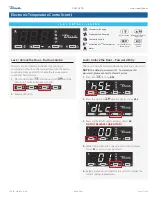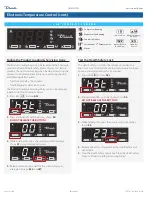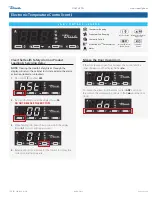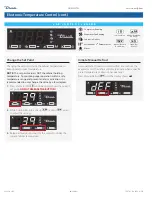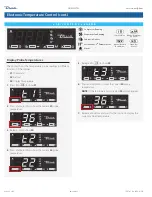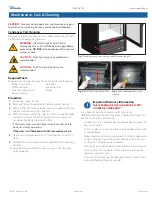
GDM HST02
www.truemfg.com
TEC_TM_158 | REV. A | EN
06/28/2022
Page 8 of 28
Installation (cont.)
Leveling
Proper leveling of your TRUE cooler is critical to operating success
(for non-mobile models). Leveling impacts effective condensate
removal and door operation.
Procedure
Level the unit front-to-back and side-to-side.
1.
Position the level on the inside floor of the unit near the doors
(the level should be parallel to cabinet front). Level the cabinet.
2.
Position the level at the inside rear of cabinet (again, the level
should be placed parallel to cabinet back). Level the cabinet.
3.
Perform procedures similar to steps 1 and 2 by placing the
level on inside floor (left and right side, parallel to the depth of
the cooler). Level the cabinet.
4.
Verify the level of the evaporator cover. See fig. 1. Adjust the
cabinet accordingly
NOTE: If the cabinet has a center leveling screw, castor, or leg,
make sure it is adjusted properly so it makes full contact with
the floor after the cabinet has been leveled.
Sealing the Cabinet to the Floor
Asphalt floors are susceptible to chemical attack. A layer of tape
may be placed on the floor prior to applying the sealant to protect
the floor.
Procedure
1.
Position the cabinet, allowing 3" (73 mm) between the wall
and the rear of the cabinet to ensure proper ventilation.
2.
Level the cabinet. The cabinet should be level side-to-side
and front-to-back. To check that the cabinet is level, place a
carpenter's level on the interior cabinet floor in four places:
a.
Position the level on the inside floor of the cabinet, near
the doors (the level should be placed parallel to the cabinet
front). Level the cabinet.
b.
Position the level at the inside rear of the cabinet (the level
should be placed parallel to the cabinet back). Level the
cabinet.
c.
Perform procedures similar to a. and b. by placing the level
on the left and right inside floor (level should be parallel to
the cabinet sides). Level the cabinet.
3.
Draw an outline of the cooler base on the floor.
4.
Raise and block the front side of the cabinet.
5.
Apply a bead of NSF-approved sealant (see list below) to the
floor, 1/2" (13 mm) inside the front part of the outline drawn in
step 4. The bead of sealant must be heavy enough to seal the
entire cabinet surface when the cabinet is lowered on top of
the sealant.
6.
Raise and block the rear of the cabinet.
7.
Apply sealant to the floor on the other three sides, as outlined
in step 5.
8.
Examine the the cabinet to ensure that it is sealed to the floor
around the entire perimeter.
NSF-Approved Sealants
• 3M #ECU800 Caulk
• 3M #ECU2185 Caulk
• 3M #ECU1055 Bead
• 3M #ECU1202 Bead
• Armstrong Cork – Rubber Caulk
• Products Research Co. #5000 Rubber Caulk
• G.E. Silicone Sealer
• Dow Corning Silicone Sealer
Fig. 6.
Loosen castor bolt.
Fig. 8.
Position multiple shims at
90˚ angles.
Fig. 7.
Install shim(s).
Leveling
Shim
Lower Rail Assembly
Bearing
Race
Snug Fit
Here
Rail End
Castor
Castor
Stem
Fig. 1.
Check the level of the evaporator cover/pan by the drain hose.

















